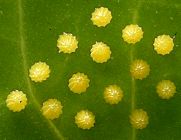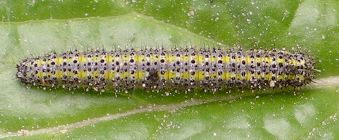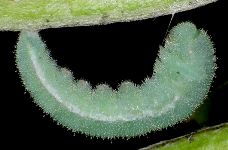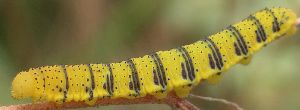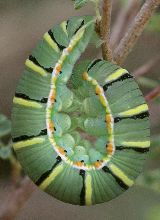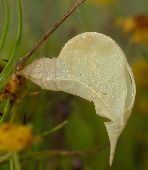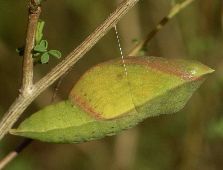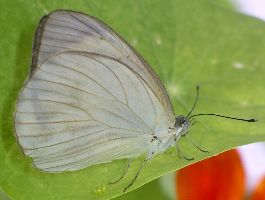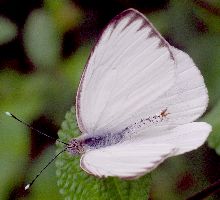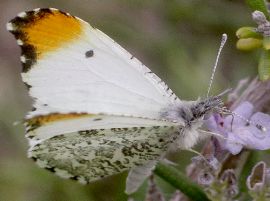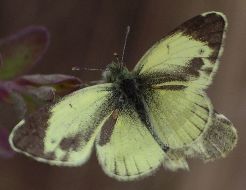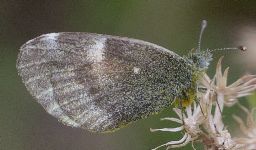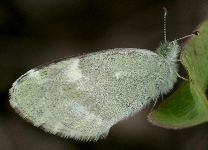
| Pieridae ~ Whites, Sulphurs |
page 1 ![]() page 2
page 2
|
The family Pieridae has some very conspicuous species. Almost everyone notices the pretty yellow butterflies that are commonly called Sulphurs or Sulfurs (depending on which spelling you prefer - they are both legitimate). There is speculation that the first use of the word "butterfly" might have referred to the European members of this family.
The eggs of pierids are sort of long and have grooves in them; they look a lot like little deflated footballs on end. I haven't found very many eggs of these butterflies, but those of Checked Whites (Pontia protodice) are laid singly on plants in the mustard family, especially Peppergrass (Lepidium virginicum). Great Southern Whites (Ascia monuste) can be raised on cultivated Nasturtium, in the family Tropaeolaceae. They lay their eggs in small groups. The resulting caterpillars are striped lengthwise in yellow and gray with black dots. The only sulphur eggs I've found are the relatively large ones of the Cloudless Sulphur (Phoebis sennae), laid singly on Partridge Pea (Cassia fasciculata).
The caterpillars of some sulphurs are sort of nondescript. They tend to look almost smooth, but close up it is evident that they are covered with tiny setae, or hairs, that often have miniscule droplets of moisture on the tips. This might be helpful in repelling parasitic wasps and flies. The segments of their bodies seem to flow seamlessly together, unless coloration provides some definition. Some sulphur caterpillars are green with a side stripe of white, such as our two common Eurema species, the Little Yellow and the Sleepy Orange, and are very hard to tell apart. Many in our area feed on legumes.
There are a couple of distinctive sulphur caterpillars, which tend to be rather specific in their host plants. One is the Cloudless Sulphur which hosts on sennas, especially Partridge Pea, as mentioned above. The larvae come in two color forms and are easy to recognize. The yellow form has black bands and the green form has yellow lateral stripes and dark blue bands.
Another unique caterpillar is that of the Southern Dogface (Colias cesonia). This particular species lacks the short bristles that characterize most sulphur larvae, and it is very smooth. The green caterpillar is marked by yellow and black bands and the lateral stripe has orange dots. They feed on legumes, especially daleas.
Sulphur pupae are attached by the rear to a branch or leaf, and a silk support keeps the top upright. The head end of the pupa is pointed. Although pupae are often right out in the open, they are well camouflaged and very difficult to see. I never saw the pupa of the Cloudless Sulphur in the above photo until the adult had emerged and the empty shell turned light brown, even though I had photographed caterpillars all around it. The only other pupa I've found is that of the Southern Dogface. It is similar in appearance to those of swallowtails.
Whites are not terribly common around here, but in the spring the Checkered White (Pontia protodice) shows up for a brief time. As noted above, the caterpillars feed on Peppergrass, which is found in weedy areas. The adults can often be found on India Mustard (Brassica juncea), an introduced weed that blooms early in the spring. The female has many dark gray markings, which give the "checkered" appearance. The male is more white with only a few dark spots.
The Great Southern White (Ascia monuste) is a rare stray to our area, but it is a popular butterfly for raising, so I've seen them regularly at a local butterfly farm. They are, as the name suggests, very large, and the male is almost pure white with just a bit of black on the wing edges. The females are more of a dirty gray with thicker black edges.
One little white butterfly that shows up very occasionally here is the Falcate Orangetip (Anthocharis midea). It flies very early in the year: only at the end of February and the beginning of March. The distinguishing characteristic of this species is the hooked forewing corner. The namesake orange color near the front wing tips is found just on males, but both genders have the finely mottled black patterns on the undersides of their hind wings, as well as the black markings along the edges of the forewings. The smallest U.S. species in this family is the Dainty Sulphur (Nathalis iole). It is very common and is found during much of the year, although it is so small that it can easily be overlooked. Sulphurs almost never perch with their wings open, so the usual view is of the undersides of their wings. I happened to get a rare shot of the upper wings of this species only because a pair were mating and one opened its wings for balance. It does give a good example, though, of the black markings that are typically found on the tops of pierids' wings but are only seen when the insects fly.
The Dainty Sulphur is not particularly yellow, although its summer form does have some gold on it. These tiny butterflies often perch with their front wings folded down behind their hind wings and the latter tend to be marked with gray and light tan or white patches. During the winter, the colors tend to be much darker, an adaptation for making the most of the sun on cold days. The wings are also hairier and their size is even smaller than usual. One common color form during the cooler moths has a decidedly green cast to it, and the resting insect looks very much like a leaf on a stem. |
page 1 ![]() page 2
page 2
![]()
